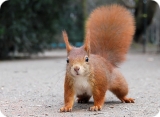séminaire du PEV – vendredi 13 décembre 2013
 Producers, Scroungers and community structure
Producers, Scroungers and community structure
William Vickery, université de Quebec à Montréal
vendredi 13 décembre 2013 à 11 heures, amphithéâtre Monge
There is now a large body of evidence that animals scrounge at frequencies predicted by producer-scrounger models. It has also been suggested that scrounging can affect population growth rates and population stability. Here I explore the effects which scrounging may have at the community level. I will show that Sciurid rodents scrounge food patches found by others. Within species, scrounging frequencies increase with patch richness as predicted by PS models. Of interest to this study, red squirrels (Tamiasciurus hudsonicus), grey squirrels (Sciurus carolinensis) and eastern chipmunks (Tamias striatus) scrounge from one another. Scrounging frequencies vary according to who is scrounging from whom. Furthermore, these species-vs-species specific rates vary with patch richness as does the rate of producing of two of the three species. The pattern of variation in scrounging frequencies and producing rates suggests a mechanism of species coexistence which may contribute to species richness within animal communities.
- titre:
- Producers, Scroungers and community structure
- intervenant:
- William Vickery
- date:
- vendredi 13 décembre 2013
- kc_data:
- a:8:{i:0;s:0:"";s:4:"mode";s:0:"";s:3:"css";s:0:"";s:9:"max_width";s:0:"";s:7:"classes";s:0:"";s:9:"thumbnail";s:0:"";s:9:"collapsed";s:0:"";s:9:"optimized";s:0:"";}
- kc_raw_content:
 Producers, Scroungers and community structure
Producers, Scroungers and community structureWilliam Vickery, université de Quebec à Montréal
vendredi 13 décembre 2013 à 11 heures, amphithéâtre Monge
There is now a large body of evidence that animals scrounge at frequencies predicted by producer-scrounger models. It has also been suggested that scrounging can affect population growth rates and population stability. Here I explore the effects which scrounging may have at the community level. I will show that Sciurid rodents scrounge food patches found by others. Within species, scrounging frequencies increase with patch richness as predicted by PS models. Of interest to this study, red squirrels (Tamiasciurus hudsonicus), grey squirrels (Sciurus carolinensis) and eastern chipmunks (Tamias striatus) scrounge from one another. Scrounging frequencies vary according to who is scrounging from whom. Furthermore, these species-vs-species specific rates vary with patch richness as does the rate of producing of two of the three species. The pattern of variation in scrounging frequencies and producing rates suggests a mechanism of species coexistence which may contribute to species richness within animal communities.
